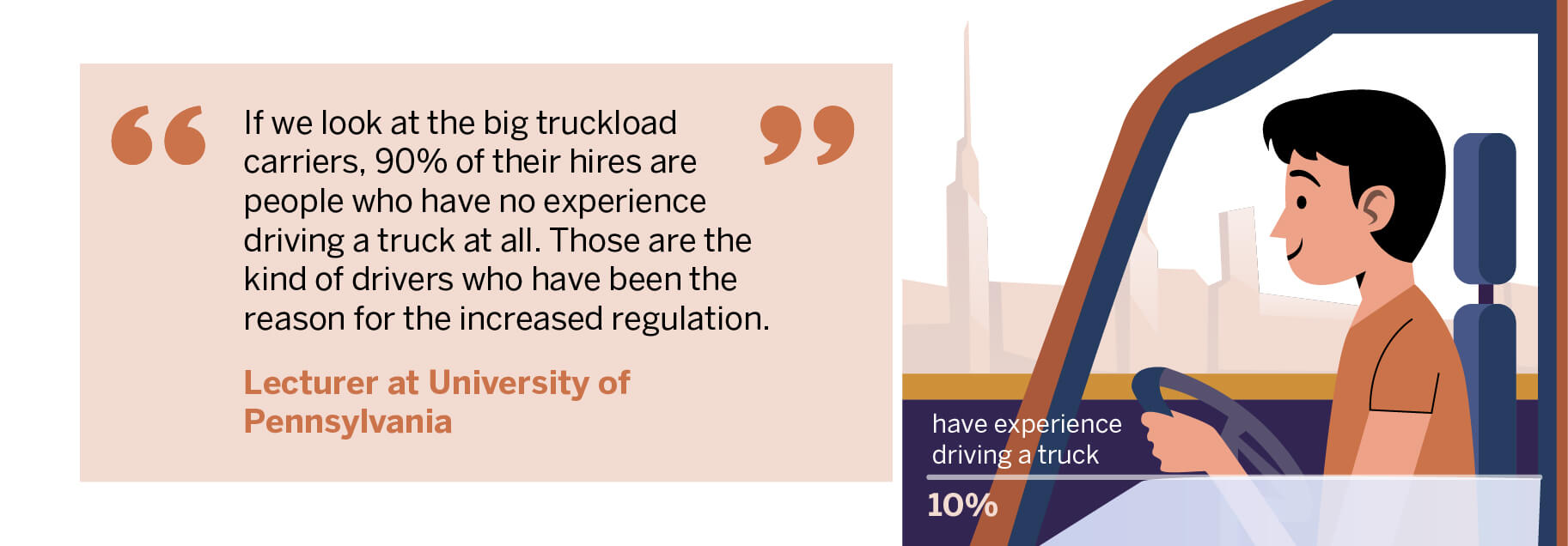Other pressures include rapid shifts in consumer demand, amplified by the COVID-19 pandemic, that have fundamentally changed the way goods are distributed. We heard that the industry’s supply-chain is being forced to evolve from one that moves a large number of items to a small number of locations, to one that can meet the demands of explosive e-commerce growth.
These factors, along with additional regulations introduced in recent years, have made the industry hugely inefficient, our experts said. “We’ve developed a system in trucking, particularly in port trucking and in long haul trucking, in which assets don’t get utilised at a very high rate, and neither does the labour that operates them,” a lecturer at the University of Pennsylvania told us.
The Electric Logging Device (ELD) mandate has been the biggest bone of contention. ELDs were introduced in 2017 as a safety measure to prohibit employees from driving for more than 11 hours during a 14-hour period. While ELDs were welcomed by those who believe the systems remove some of the pressure associated with driving and enable drivers to be safer, others condemn them.
As drivers are paid by the mile, many have, for example, seen their weekly pay sink and now feel restricted in their work. Previously, hours of service were logged manually, with drivers typically starting the clock once they had loaded the goods. “When that ELD mandate went into effect, all those owner-operators in small companies that were not counting or not starting their day until they were loaded and ready to make money driving revenue-generating miles… saw a big decrease in their asset utilisation,” an executive at Riteload said. Smaller companies with limited funds to pay for the equipment are suffering the most, with many claiming their livelihoods are at risk. Due to the 14-hour rule, drivers are using 70-75% of their hours each day, we heard. “That’s a really low number,” the specialist continued. “They’ve got to take another look at this hours of service problem.”
Other regulations, particularly in California, are also restricting driver capacity. Shipping pile-ups at ports in the Golden State are part of the global supply-chain crisis caused by COVID-19. However, experts also point to a law which dictates that only company drivers for large carriers can access the ports. This has been particularly problematic, as over 80% of the market are independent contractors or drivers operating in a fleet of 20 or fewer trucks, the Riteload executive noted. Meanwhile, the potential expansion of Assembly Bill 5 (AB5) — which reclassifies many workers in the state as employees rather than independent contractors — could also reshape the way carriers and drivers do business.
While an ageing workforce is often blamed for the shortage of drivers, Interviews suggest new regulations are making the trade lose some of its appeal. Indeed, the University of Pennsylvania lecturer noted that three times more people have been recruited or trained to drive trucks than there are those jobs available. “There’s really no shortage of drivers or of labour,” they said. We were told that recruitment and retention practices are also influencing this trend, with many carriers favouring the costs of training new workers over retaining experienced ones. According to one expert, 90% of hires at large carriers “have no experience driving a truck at all”, resulting in regulations that are now restricting drivers’ time and productivity, and causing high employee turnover. “It’s just an unbelievably inefficient system that we’ve developed,” the Riteload executive said.

Despite these headwinds, Interviews suggest “we’re going to see really tight freight markets through next year [2022]”, with prices expected to increase further. While this is good news for some, one specialist noted that, for most carriers, top-line numbers have stagnated in recent years. “Carriers that… were not doing well are now eking out a profit in some cases, but the top-line growth isn’t there and that’s what Wall Street is concerned about,” the Riteload executive said. Meanwhile, automated driving is gaining ground and could make prices more competitive, particularly in the long term. “Within 10 years, I expect that we’ll start to see a good portion of the southern US where key lanes are becoming automated, and the driver force is really starting to feel it in those areas,” the University of Pennsylvania lecturer said.
In some ways, the US trucking industry faces an uncertain future. The need for drivers is not diminishing, but the type of jobs available might soon change. Indeed, we heard that “millions of new jobs” in freight transportation will be created in the next decade thanks to the continued ascent of e-commerce and consumer spending, which are driving greater demand for last-mile and lighter-than-truckload services. Even if some capacity shifts to railroads, where experts are seeing a surge in demand for double-stack containers, drivers will still be required to collect and deliver goods. “We’re still going to need drivers and it’s not going to get any softer from that standpoint,” the expert said.
How regulatory factors continue to shape the landscape remains to be seen, but what is critically important for the industry in this transformative period, our specialists say, is a stable labour market with sustainable career paths. “That’s the big positive on the policy side that could come, a real move to an alternative pipeline of apprenticeships where people have local jobs.”
The information used in compiling this document has been obtained by Third Bridge from experts participating in Forum Interviews. Third Bridge does not warrant the accuracy of the information and has not independently verified it. It should not be regarded as a trade recommendation or form the basis of any investment decision.
For any enquiries, please contact sales@thirdbridge.com




